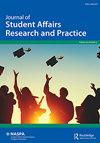青少年心理健康状况对成本和未来就业状况的影响
IF 0.8
Q3 EDUCATION & EDUCATIONAL RESEARCH
Journal of Student Affairs Research and Practice
Pub Date : 2023-05-31
DOI:10.47611/jsrhs.v12i2.4207
引用次数: 0
摘要
世界卫生组织将精神健康状况定义为"包括精神失常和社会心理残疾以及与严重痛苦、功能受损或自残风险有关的其他精神状态"(世界卫生组织,2022b)。在青少年中,心理健康状况,特别是抑郁和焦虑呈上升趋势(拉辛等人,2021年)。以前的研究通常着眼于相反的影响(例如,经济恶化对青少年心理健康的影响)或更广泛的影响(例如,所有年龄组的心理健康状况对整个经济的影响)。本综述旨在量化青少年心理健康状况对未来就业状况的成本和影响。虽然这篇综述调查了整体的精神健康状况,但它也具体说明了抑郁、焦虑和心理困扰,以及一般的精神健康问题。使用谷歌学术对上述指标的成本进行了回顾,回顾了来自美国、澳大利亚和几个欧洲国家的先前文献。结果表明,青少年的心理健康状况增加了家庭和社会的成本,同时也影响了未来的就业状况,不同类型的心理健康状况对家庭和社会的影响程度不同。最后,我们提出了需要改进的具体领域,以尽量减少研究地区心理健康状况的经济危害。本文章由计算机程序翻译,如有差异,请以英文原文为准。
Effects of Adolescent Mental Health Conditions on Costs and Future Employment Status
The World Health Organization defines mental health conditions to “include mental disorders and psychosocial disabilities as well as other mental states associated with significant distress, impairment in functioning, or risk of self-harm” (World Health Organization, 2022b). There has been an increasing trend of mental health conditions, specifically depression and anxiety, among adolescents (Racine et al., 2021). Previous studies typically look at the reverse effect (e.g. the effect of a worsening economy on adolescent mental health) or a more generalized effect (e.g. the effect of mental health conditions among all age groups on the whole economy). This review seeks to quantify the costs and effect on future employment status which adolescent mental health conditions have. While this review examines overall mental health conditions, it also specifies depression, anxiety, and psychological distress, along with general areas of mental health problems. Previous literature from the United States, Australia, and several European countries were reviewed using Google Scholar on costs on the indicators above. The results indicate that mental health conditions among adolescents increase costs to families and society while also hurting future employment status, and different types of mental health conditions have different levels of effects. Finally, we suggest specific areas needed for improvement in order to minimize the economic harms of mental health conditions in the researched areas.
求助全文
通过发布文献求助,成功后即可免费获取论文全文。
去求助
来源期刊

Journal of Student Affairs Research and Practice
EDUCATION & EDUCATIONAL RESEARCH-
CiteScore
2.40
自引率
9.10%
发文量
50
期刊介绍:
The vision of the Journal of Student Affairs Research and Practice (JSARP) is to publish the most rigorous, relevant, and well-respected research and practice making a difference in student affairs practice. JSARP especially encourages manuscripts that are unconventional in nature and that engage in methodological and epistemological extensions that transcend the boundaries of traditional research inquiries.
 求助内容:
求助内容: 应助结果提醒方式:
应助结果提醒方式:


